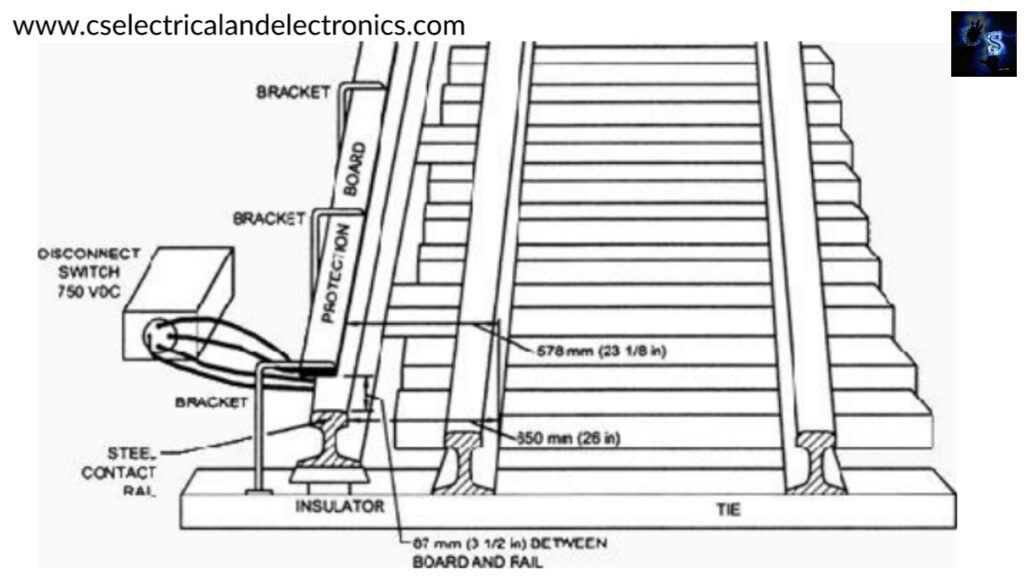What Is Third Rail System, Working Of Third Rail System, History
Hello guys, welcome back to our blog. In this article, we will discuss what is third rail system, the working of the third rail system, and the history of this system, we will try to explain this topic with a diagram.
If you have any electrical, electronics, and computer science doubts, then ask questions. You can also catch me on Instagram – CS Electrical & Electronics.
Also, read:
- Types Of Motor Used In Electric Train Or Traction, Motors In Train.
- What Is Megger, Working Principle, Advantages, Types, Construction?
- Top 20 Electric Traction Interview Questions And Answers.
What Is Third Rail System
The process of providing power to the railway locomotive using an additional semi-continuous rigid conductor placed alongside or between the rails of a railway track is called the Third rail system. It is popularly known as the conductor rail. The conductor rile is made up of either high steel or aluminum.
In most of the systems, the conductor rail is used at the end of the sleepers of running train or in the centre of the rails. The general purpose of the third rile system is to return the traction current to the generating station without losses. The third rail is suggested as the efficient process to collect the traction current and send it to the generation system by preventing external losses. The placement of the third rail system is of three types:
- Contact – top
- Contact – bottom
- Side – contact
According to the type of placement of the third rile system the train uses the contacts to collect the traction current. The train has metal contact shoes which are used to be in contact with the third rail system.
The electrical train uses the electric wire for contacts but to reduce the electric circuits separate stainless steel contacts are used as upgrades in place of wires. The contact shoes can be placed at the top, bottom, or side according to the conductor rail placement.

The conductor rail and train contact are variable according to the modern ages. In the early years, it will be placed in the top contact, but for the sake of protection, the third rail is placed in different forms.
The conductor rail mostly provides dc supply. From the above figure, we can see that the distribution box is placed beside the railway track. It will give the high voltage dc supply to the conductor rail. The supply will be passed to the whole conductor rail and the contact shoes from the locomotive will collect the current and distribute them into the whole cabin.
DC traction current is directly given to the third rail. The third rail was first experimented with in 1879 by Siemens & Helsky in Germany at Berlin Industrial Exposition. It is used as the additional rail to collect the power but later to run the tramways with a light load this is coming into the implementation. But the main disadvantage of the third rail is it is only possible in the DC supply locomotion.
Watch Animated Video – Click Here.
The third rail can be used simultaneously with the overhead transmission system in traction. For high-speed locomotion, the power requirement is high for the supply of heavy current both the overhead and the third rail system are used as the mixed system. The major application of the third rail is to supply additional power when the shortage of power and to provide a high rate of protection such as no disturbances in the rail tracks.
The supply from both types is popularly known as double electrification. Overhead transmission is the AC supply and the third-rail system is the DC supply, so there will be huge differences in the supplies. In this type of situation, either overhead or third rail should be converted to one of them, this makes the engine be upgraded with the heavy converting equipment. This type of conversion majorly made double electrification be avoided.
Modern Age Of Third Rail System

The third rail system was first to come into complete action in 1906. The first locomotive is fully made up of the third rail system in 1906, and from that, there came different changes in the third rail_system as per modern technology.
Nowadays the third rail_system is used in many locomotives. Metro locomotives are the major applications of the third-rail system. In the region where the overhead lines are not suitable there the third rail system is used as an alternative. The main reason for using the third rail system in Metro is, they are used in the center of the populated locations so placing the overhead lines is not as much easy.
Therefore, there is only one option to use the third rail system in place of the overhead system. Tramways and Streetcar locomotives are mainly used in road transport with separate tracks.
So, overhead transmission is not possible that’s why the third rail is used and the supply will be direct traction current. The third rail system gave the next generation of electrical traction. The modern era will see traction without wires with high efficiency.
This was about “What Is Third Rail System“. I hope this article may help you all a lot. Thank you for reading.
Also, read:
- 10 Tips To Maintain Battery For Long Life, Battery Maintainance
- 10 Tips To Save Electricity Bills, Save Money By Saving Electricity
- 100 (AI) Artificial Intelligence Applications In The Automotive Industry
- 100 + Electrical Engineering Projects For Students, Engineers
- 1000+ Control System Quiz, Top MCQ On Control System
- 1000+ Electrical Machines Quiz, Top MCQs On Electrical Machines
- 1000+ MATLAB Simulink Projects For MTech, Engineering Students
- 2024 Is About To End, Let’s Recall Electric Vehicles Launched In 2024

